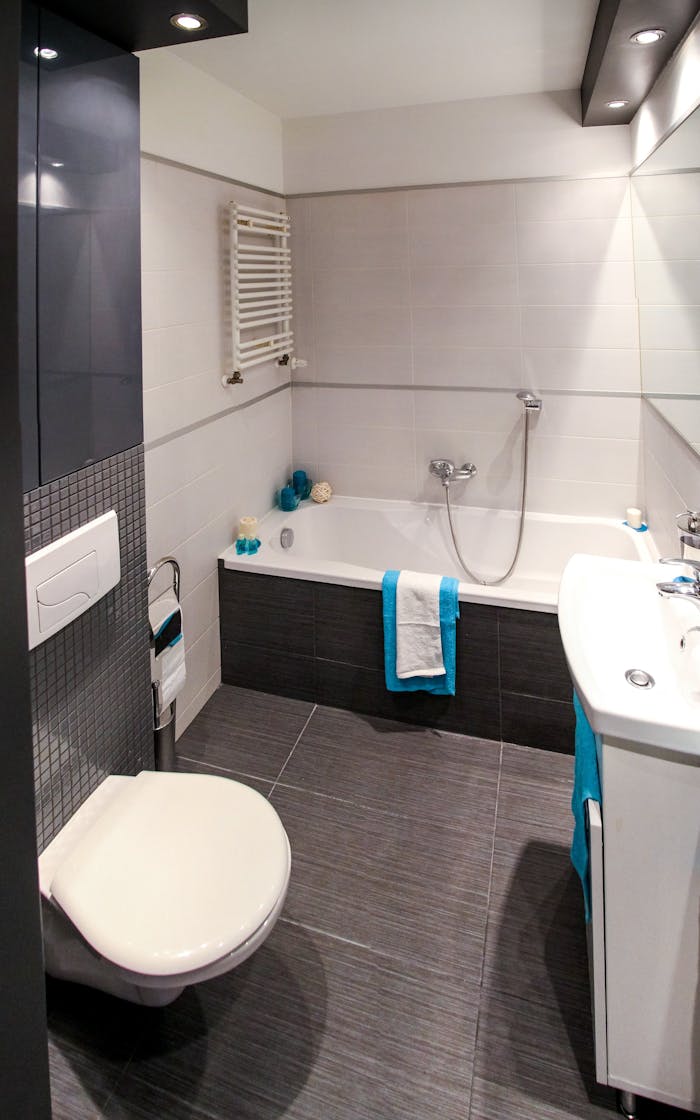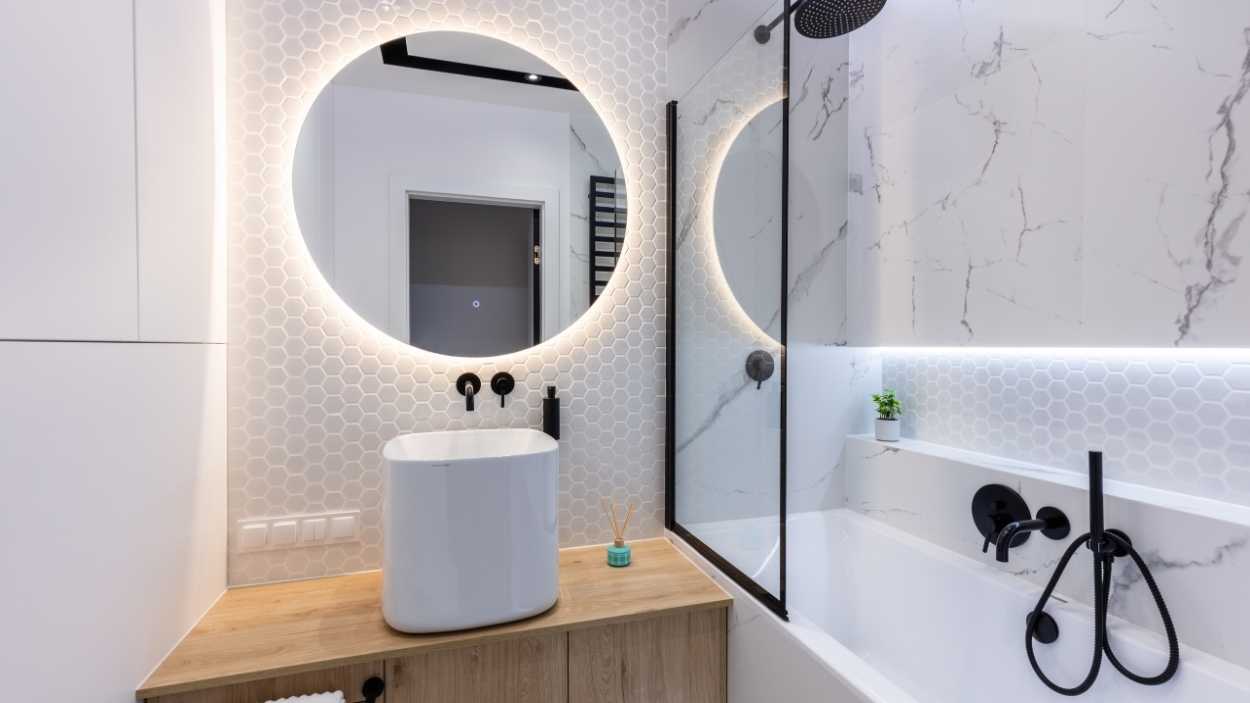After your bathroom renovation, it’s essential to clean your new tiles to prevent damage and guarantee a sparkling finish.
First, gather necessary supplies, clear the area of debris, and prioritize surface protection. Remove renovation residue by sweeping or vacuuming, then mop with warm water and a gentle cleaner.
Consider using a steam cleaner for stubborn residue. Next, clean your tile type specifically, whether it’s ceramic, porcelain, or natural stone.
Finally, disinfect and seal your tiles to protect them from stains. For a deeper clean and ongoing maintenance, you’ll want to explore more advanced techniques and best practices to keep your bathroom tiles looking their best.
Key Takeaways
• Remove renovation residue by sweeping or vacuuming, then mopping with a gentle cleaner and warm water.
• Use eco-friendly cleaners and gentle scrubbers to avoid damaging tiles or grout.
• Clean different tile types with appropriate products, such as pH-neutral cleaners for natural stone tiles.
• Disinfect tiles with a water and cleaning product solution, then rinse thoroughly to remove residue.
• Establish a regular cleaning routine, focusing on grout care to prevent dirt and grime buildup.
Preparing for Tile Cleaning
Before you start cleaning your newly installed bathroom tiles, take a few minutes to gather the necessary supplies and clear the area to guarantee a smooth and efficient cleaning process. This preparatory phase is vital to make sure you’re equipped with the right cleaning products and tools to tackle the job effectively.
Start by collecting a gentle tile cleaner, a scrub brush, and a microfiber cloth. If you have grout lines, consider a grout scrubbing brush to address those areas. Don’t forget to grab a bucket of warm water and a mop for any larger areas. Clear the area of any debris, such as construction materials or renovation residue, to prevent scratching your new tiles.
It’s important to prioritize surface protection during the cleaning process. Make sure you’re using cleaning products specifically designed for your tile type to avoid damaging the surface. Effective techniques, such as cleaning in sections and working from top to bottom, will help maintain the integrity of your tiles.
Additionally, consider implementing a regular tile maintenance routine to prevent dirt and grime buildup. By taking the time to prepare and plan, you’ll be able to achieve a sparkling clean bathroom that looks like new.
Removing Renovation Residue
You’ll likely be surprised by the amount of dust, dirt, and debris that renovation residue can leave behind on your newly installed bathroom tiles. This residue can be a real challenge to clean, but it’s essential to remove it to maintain the appearance and longevity of your tiles.
To remove renovation residue, start by sweeping or vacuuming the floor to remove any loose debris. Then, mix a solution of warm water and an eco-friendly cleaner, and mop the tiles gently. For more stubborn residue, consider using a steam cleaner, which can be especially effective at breaking down dirt and grime without damaging your tiles.
Some important considerations to keep in mind:
- Regular grout maintenance is important to prevent dirt and debris from accumulating in the grout lines.
- Always choose eco-friendly cleaners that are safe for your tile type and the environment.
- If you’re not comfortable tackling the job yourself, consider hiring professional services to make sure the job is done efficiently and effectively.
- DIY solutions can be effective, but be sure to follow the manufacturer’s instructions and take necessary safety precautions.
Cleaning Different Tile Types
As you explore the world of bathroom tile cleaning, it’s important to recognize that different tile types require tailored cleaning approaches to maintain their unique characteristics and longevity. For instance, ceramic and porcelain tiles are more resistant to stains and moisture, making them easy to clean with a gentle detergent and warm water.
On the other hand, natural stone tiles like marble, granite, and travertine require more delicate care, as they’re prone to etching and staining. You’ll need to use a pH-neutral cleaning product and avoid acidic substances to prevent damage.
When it comes to grout maintenance, you’ll need to scrub the grout lines regularly to prevent dirt and mildew buildup. A gentle grout cleaner and a soft-bristled brush should do the trick. For more stubborn stains, you can use a baking soda and water paste or a commercial stain remover. Remember to always test a small area first to make sure the cleaning product or solution won’t damage your tiles.
Tile sealing is also important, especially for porous tiles like natural stone or concrete. This will help protect them from stains and make cleaning easier. When choosing cleaning products, opt for those specifically designed for your tile type, and always follow the manufacturer’s instructions.
Disinfecting and Sealing Tiles
After completing the cleaning process, it’s important to disinfect your bathroom tiles to eliminate any remaining bacteria and germs that can spread illness. This vital step guarantees a hygienic and safe environment for you and your family.
To disinfect your tiles, mix a solution of water and a gentle cleaning product, such as bleach or a quaternary ammonium compound. Apply the solution to the tiles and grout using a soft cloth or sponge. Let it sit for 10-15 minutes to allow the solution to penetrate and kill bacteria. Then, scrub the tiles gently with a soft-bristled brush to remove any remaining dirt and grime. Rinse the tiles thoroughly with clean water to remove any residue.
Here are some additional tips to keep in mind:
- Use a grout-specific cleaner to maintain your grout lines and prevent mould and mildew growth.
- Regularly seal your tiles to protect them from stains and make cleaning easier.
- Preventing mould growth is essential in humid bathroom environments; ensure good ventilation and fix any water leaks promptly.
- Always follow the manufacturer’s instructions when using cleaning solutions to avoid damaging your tiles.
Maintaining Clean Bathroom Tiles
By establishing a regular cleaning routine, you can maintain the cleanliness and appearance of your bathroom tiles, guaranteeing a hygienic and visually appealing space. Daily maintenance is essential, and it’s important to focus on grout care to prevent dirt and grime buildup. Use eco-friendly cleaners that are gentle on the environment and your tiles.
Steam cleaning is an excellent way to sanitize your bathroom, removing dirt and grime without harsh chemicals. The benefits of steam cleaning include a deeper clean, reduced water usage, and a fresher scent.
If you’re short on time or need a deeper cleaning, consider hiring professional cleaning services. They’ll have the necessary equipment and expertise to tackle tough stains and grout lines.
Preventing mold and mildew growth is crucial in bathrooms, where moisture accumulates. Regular cleaning and drying of the area, especially around the shower and bathtub, will help prevent these unwanted growths. Additionally, ensure good ventilation in your bathroom to reduce humidity.
Frequently Asked Questions
Conclusion
You’ve invested time and money into your dream bathroom renovation, and now it’s essential to maintain its beauty. By following these guidelines, you’ll be able to clean your bathroom tiles effectively, removing dirt, grime, and soap scum without damaging their surface.
With the right techniques and products, your tiles will remain a stunning focal point in your bathroom for years to come.



